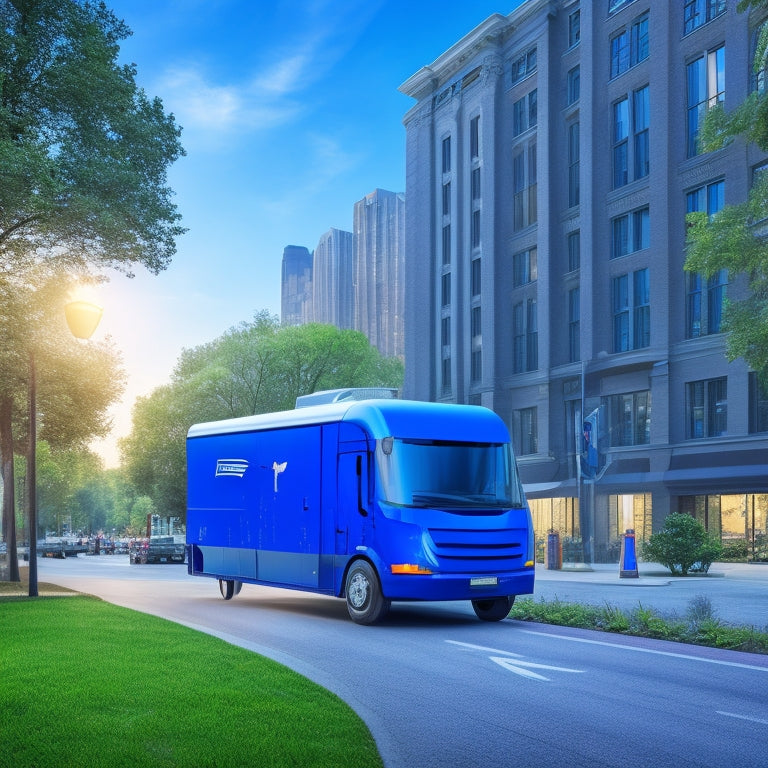
USPS Pushed to Amp Up Electric Fleet
Share
The United States Postal Service (USPS) is accelerating its efforts to electrify its fleet, with plans to make 62% of its 106,000 new vehicles electric. This move aims to reduce the organization's environmental footprint and operational costs, focusing on operational efficiency and a cleaner environment. The initiative will reduce greenhouse gas emissions by 3.9 million metric tons by 2030, while also providing cost savings and improved gas mileage. As the USPS continues to modernize its fleet, the future of electric vehicles in the organization's operations holds much promise, and further exploration is needed to uncover the full scope of this ambitious initiative.
Key Takeaways
• USPS aims to electrify its fleet with 62% of 106,000 new vehicles being electric, focusing on operational efficiency and reducing environmental footprint.
• The initiative will reduce greenhouse gas emissions by 3.9 million metric tons by 2030, contributing to a cleaner environment and providing financial benefits.
• USPS has invested nearly $3 billion in its next-generation vehicle fleet, with an initial order of over 10,000 electric vehicles from Oshkosh Defense.
• The electric fleet will enhance operational efficiency, reduce emissions, and provide long-term cost savings, supporting USPS's commitment to responsible electrification.
• The shift towards electric vehicles will lead to substantial cost savings, improved gas mileage, and a positive impact on the environment, aligning with USPS's goal of reducing greenhouse gas emissions.
Electric Fleet Plan and Progress
The United States Postal Service (USPS) has outlined an ambitious plan to electrify its fleet, with a goal of having a majority of electric vehicles within the next decade, comprising 62% of the 106,000 new vehicles to be acquired.
This initiative is a significant step towards fleet modernization, focusing on operational efficiency and reducing the environmental footprint of its delivery operations. The USPS plans to achieve this goal by acquiring a mix of custom-built and commercial off-the-shelf electric vehicles, with 75% of its Next-Generation Delivery Vehicles being electric.
This strategic move will not only contribute to a cleaner environment but also enhance the overall operational efficiency of the USPS.
Environmental Impact and Benefits
By shifting to an electric fleet, the USPS initiative is poised to greatly diminish its environmental footprint, with an expected reduction of 3.9 million metric tons of greenhouse gas emissions by 2030. This significant reduction will have a profound impact on the environment, contributing to a cleaner and healthier ecosystem.
Additionally, the electric vehicles are expected to provide substantial fuel cost savings, with a minimum 70-mile range on a single charge. This will not only benefit the environment but also reduce operational costs for the USPS.
The improved gas mileage of proposed gasoline-powered vehicles will further enhance the environmental benefits of the initiative. Overall, the USPS electric fleet plan is set to have a profoundly positive impact on the environment, while also providing financial benefits.
Fleet Acquisition Strategy
To accelerate the electrification of its fleet, USPS is adopting a strategic acquisition approach. This approach is characterized by smaller, more frequent purchases to increase the proportion of electric vehicles. This purchase strategy enables the organization to respond quickly to emerging market trends and technological advancements in electric vehicles.
By adopting this approach, USPS can rapidly scale up its electric fleet, reducing greenhouse gas emissions and fuel costs. The acquisition approach also allows for greater flexibility in ordering commercial off-the-shelf vehicles, enabling the organization to take advantage of economies of scale and negotiate better prices.
This strategic acquisition strategy is essential in supporting USPS's commitment to responsible electrification, aligned with its operational strategy.
Investment in Next-Generation Vehicles
USPS has invested nearly $3 billion in its next-generation vehicle fleet, with an initial order placed with Oshkosh Defense, marking a significant milestone in its commitment to modernize its vehicle fleet and reduce its environmental footprint.
This investment is a pivotal step towards adopting clean energy and sustainability practices, aligning with the USPS's goal of reducing greenhouse gas emissions. The initial order includes over 10,000 electric vehicles, demonstrating the organization's dedication to evolving towards a more environmentally friendly fleet.
This investment will not only contribute to a significant reduction in carbon emissions but also pave the way for further advancements in clean energy adoption, ultimately supporting the USPS's commitment to sustainability practices.
Impact of Electric Vehicle Initiative
The widespread adoption of electric vehicles is poised to have a profound impact on the environment, with the USPS's electric vehicle initiative expected to reduce greenhouse gas emissions by 3.9 million metric tons by 2030. This significant carbon reduction will contribute substantially to environmental conservation.
Additionally, the initiative is anticipated to yield substantial cost savings, as electric vehicles boast a minimum 70-mile range on a single charge, reducing fuel costs. The improved gas mileage of proposed gasoline-powered vehicles will also contribute to cost savings.
As the USPS moves towards a majority electric fleet, it is likely to experience long-term cost savings, making the investment in electric vehicles a prudent decision for the organization's operational strategy.
Challenges and Future Outlook
Implementing a majority electric fleet comes with its set of challenges, including the need for significant investments in infrastructure to support widespread electric vehicle charging. Infrastructure challenges include the installation of charging stations and upgrading electrical grids to accommodate the increased demand.
Additionally, the USPS will need to address training needs for employees to guarantee a seamless shift to electric vehicles. This may involve educating staff on charging procedures, vehicle maintenance, and troubleshooting.
As the USPS continues to expand its electric fleet, it will be vital to address these challenges to guarantee a successful shift. By doing so, the USPS can overcome these hurdles and achieve its ambitious electrification goals.
Roadmap to Full Electrification
Achieving a fully electrified fleet will require a well-planned roadmap, outlining specific milestones and timelines to guide the USPS's ambitious electrification efforts.
A key component of this roadmap is a detailed progression timeline, outlining the pace and scope of electric vehicle adoption.
This timeline should be informed by infrastructure readiness, guaranteeing that charging infrastructure and supporting systems are in place to support the growing electric fleet.
Frequently Asked Questions
How Will USPS Ensure Widespread Charging Infrastructure for Electric Vehicles?
To guarantee widespread charging infrastructure, USPS can establish strategic Charging Hubs and collaborate with utilities to assess and upgrade Grid Capacity, guaranteeing seamless and efficient electric vehicle charging across its vast delivery network.
What Incentives Will Be Offered to Encourage Employee Adoption of Evs?
As the world shifts gears towards sustainability, USPS can incentivize employee adoption of EVs by offering employee discounts on home charging installations, fostering a culture of eco-friendliness and reducing range anxiety.
Will the Electric Fleet Be Used for All Mail Routes, Including Rural Areas?
The electric fleet's rural deployment will prioritize Delivery Equity, ensuring equal access to eco-friendly mail services. Rural Logistics will be optimized to accommodate electric vehicles, addressing range and charging concerns, and promoting a seamless shift to sustainable rural mail delivery.
How Will USPS Balance the Need for Electric Vehicles With Varying Climate Demands?
To balance electric vehicle needs with varying climate demands, USPS will prioritize climate resilience by selecting temperature-resistant batteries, optimizing vehicle performance in extreme temperatures, and strategically deploying vehicles to minimize climate-related downtime.
Can the Electric Vehicle Fleet Be Used for Other Government Agencies or Municipalities?
The USPS electric vehicle fleet can potentially be leveraged for government partnerships and municipal leasing, fostering a collaborative approach to sustainable transportation and emissions reduction, while exploring innovative leasing models and shared infrastructure.
Related Posts
-

Why Choose Cool Roofs in Scorching Climates?
You opt for cool roofs in scorching climates because they enable you to reclaim control over your energy consumption ...
-

7 Solar-Safe Window Solutions for Earth-Conscious Homeowners
As an earth-conscious homeowner, you're likely keen to find solar-safe window solutions that align with your values. ...
-

Why EVs Inspire Earth-Conscious Home Design Choices
As you shift to an electric vehicle, you're not just switching to a greener ride, you're igniting a broader commitmen...


